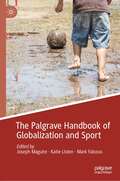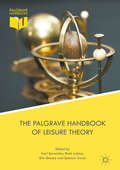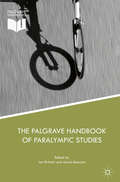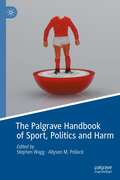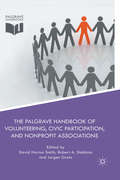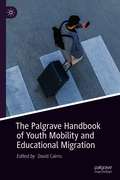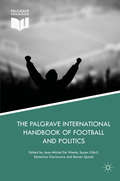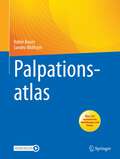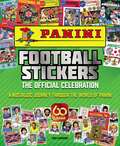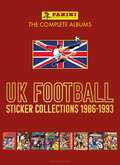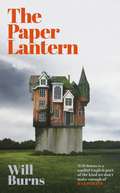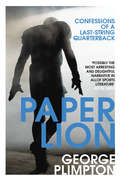- Table View
- List View
The Palgrave Handbook of Globalization and Sport
by Joseph Maguire Katie Liston Mark FalcousThis handbook illustrates the utility of global sport as a lens through which to disentangle the interconnected political, economic, cultural, and social patterns that shape our lives. Drawing on multidisciplinary perspectives, it is organized into three parts. The first part outlines theoretical and conceptual insights from global sport scholarship: from the conceptualization and development of globalization theories, transnationalism and transnational capital, through to mediasport, roving coloniality, and neoliberal doctrine. The second part illustrates the varied flows within global sport and the ways in which these flows are contested, across physical cultures/sport forms, identities, ideologies, media, and economic capital. Diverse topics and cases are covered, such as sport business and the global sport industry, financial fair play, and global mediasport. Finally, the third part explores various aspects of global sport development and governance, incorporating insights from work in the Global South. Across all of these contributions, varied approaches are taken to examine the ‘power of sport’ trope, generating a thought-provoking dialogue for the reader. Featuring an accomplished roster of contributors and wide-ranging coverage of key issues and debates, this handbook will serve as an indispensable resource for scholars and students of contemporary sports studies.
The Palgrave Handbook of Leisure Theory
by Karl Spracklen Brett Lashua Erin Sharpe Spencer SwainThis is the first handbook devoted entirely to leisure theory, charting the history and philosophy of leisure, theories in religion and culture, and rational theories of leisure in the Western philosophical tradition, as well as a range of socio-cultural theories from thinkers such as Adorno, Bauman, Weber and Marx. Drawing on contributions from experts in leisure studies from around the world, the four sections cover: traditional theories of leisure; rational theories of leisure; structural theories of leisure; and post-structural theories of leisure. The Palgrave Handbook of Leisure Theory is essential reading for students and scholars working in leisure studies, social theory as well as those working on the problem of leisure in the wider humanities and social sciences.
The Palgrave Handbook of Masculinity and Sport
by Eric Anderson Jamie Cleland Rory MagrathOver the past two decades there has been a rapid transformation of masculinities in the West, largely facilitated by a decline in cultural homophobia. The significant changes in the expression of masculinity, particularly among younger generations of men, have been particularly evident in men’s team sports, which have become an increasingly diverse and inclusive culture. Drawing upon work from a wide range of established and emerging international scholars, this handbook provides a comprehensive and interdisciplinary analysis of the contemporary relationship between masculinity and sport. It covers a range of areas including history, media, gender, sexuality, race, violence, and fandom, considering how they impact a range of different sports across the world. Students and scholars across many disciplines will find the unparalleled overview provided by these specially commissioned chapters an invaluable resource.
The Palgrave Handbook of Olympic Studies
by Helen Jefferson Lenskyj and Stephen WaggA comprehensive, state-of-the-art reference collection, bringing together an authoritative and international line-up of scholars to examine key social and political issues related to the Olympics. An essential, 'one-stop' volume for a wide range of academics, students and researchers.
The Palgrave Handbook of Paralympic Studies
by Aaron Beacom Ian BrittainThis handbook provides a critical assessment of contemporary issues that define the contours of the Paralympic Movement generally and the Paralympic Games more specifically. It addresses conceptualisations of disability sport, explores the structure of the Paralympic Movement and considers key political strategic and governance issues which have shaped its development. The Palgrave Handbook of Paralympic Studies is written by a range of international authors, a number of whom are senior strategists as well as academics, and explores legacy themes through case studies of recent Paralympic games. Written in the wake of the 2016 Rio Paralympic Games, it provides an assessment of contemporary challenges faced by the International Paralympic Committee and other key stakeholders in the Paralympic Movement. Its critical assessment of approaches to branding, classification, social inclusion and technological advances makes this handbook a valuable resource for undergraduate study across a range of sport and disability related programmes, as well as a point of reference for researchers and policy makers.
The Palgrave Handbook of Sport, Politics and Harm
by Stephen Wagg Allyson M. PollockThis book looks historically at the harm that has been inflicted in the practice of sport and at some of the issues, debates and controversies that have arisen as a result. Written by experts in history, sociology, sport journalism and public health, the book considers sport and injury in relation to matters of social class; gender; ethnicity and race; sexuality; political ideology and national identity; health and wellbeing; childhood; animal rights; and popular culture. These matters are, in turn, variously related to a range of sports, including ancient, pre- and early industrial sports; American football; boxing; wrestling and other combat sports; mountaineering; horseracing; cycling; motor racing; rugby football; cricket; association football; baseball; basketball; Crossfit; ice hockey; Olympic sports; Mixed Martial Arts; and sport in an imagined dystopian future.
The Palgrave Handbook of Volunteering, Civic Participation, and Nonprofit Associations
by Robert A. Stebbins David Horton Smith Jurgen GrotzWritten by over 200 leading experts from over seventy countries, this handbook provides a comprehensive, state-of-the-art overview of the latest theory and research on volunteering, civic participation and nonprofit membership associations. The first handbook on the subject to be truly multinational and interdisciplinary in its authorship, it represents a major milestone for the discipline. Each chapter follows a rigorous theoretical structure examining definitions, historical background, key analytical issues, usable knowledge, and future trends and required research. The nine parts of the handbook cover the historical and conceptual background of the discipline; special types of volunteering; the major activity areas of volunteering and associations; influences on volunteering and association participation; the internal structures of associations; the internal processes of associations; the external environments of associations; the scope and impacts of volunteering and associations; and conclusions and future prospects. This handbook provides an essential reference work for third-sector research and practice, including a valuable glossary of terms defining over eighty key concepts. Sponsored by the International Council of Voluntarism, Civil Society, and Social Economy Researcher Associations (ICSERA; www.icsera.org), it will appeal to scholars, policymakers and practitioners, and helps to define the emergent academic discipline of voluntaristics.
The Palgrave Handbook of Youth Mobility and Educational Migration
by David CairnsThis handbook provides an overview of developments in the youth mobility and migration research field, with specific emphasis on movement for education, work and training purposes, encompassing exchanges sponsored by institutions, governments and international agencies, and free movement. The collection features over 30 theoretically and empirically-based discussions of the meaning and key aspects of various forms of mobility as practiced in contemporary societies, and concludes with an exploration of the costs and benefits of moving abroad to individuals and societies at a time when the viability of free circulation is being called into question. The geographical scope of the book covers Europe, Asia, Australia and the Americas, and takes into account socio-economic and regional inequalities, as well as recent developments such as the refugee crisis, Brexit and the Covid-19 pandemic. The book integrates the fields of youth mobility and migration studies, creating opportunities for the establishment of a new paradigm for understanding the spatial circulation of youth and young adults in the twenty-first century.
The Palgrave Handbook of Youth Mobility and Educational Migration
by David CairnsThis handbook provides an overview of developments in the youth mobility and migration research field, with specific emphasis on movement for education, work and training purposes, encompassing exchanges sponsored by institutions, governments and international agencies, and free movement.The collection features over 30 theoretically and empirically-based discussions of the meaning and key aspects of various forms of mobility as practiced in contemporary societies, and concludes with an exploration of the costs and benefits of moving abroad to individuals and societies at a time when the viability of free circulation is being called into question. The geographical scope of the book covers Europe, Asia, Australia and the Americas, and takes into account socio-economic and regional inequalities, as well as recent developments such as the refugee crisis, Brexit and the Covid-19 pandemic. The book integrates the fields of youth mobility and migration studies, creating opportunities for the establishment of a new paradigm for understanding the spatial circulation of youth and young adults in the twenty-first century.
The Palgrave Handbook on the Economics of Manipulation in Sport
by Markus Breuer David ForrestSport has enjoyed steadily increasing prominence and economic importance since the Millennium. But threats to its integrity appear to have grown in parallel, undermining the very sense of innocence and fun which is an important part of its appeal. Threats to the spirit of sport come from internal, external and even state actors, who seek either to manipulate events on the field or to exploit the institutions of sport for their own ends. As the reputation of sport becomes more tarnished as a result, its sustainability as a significant part of the entertainment industry is called into question and loss of reputation may even result in decline in recreational play. In this wide-ranging collection of essays, the international team of contributors explores the structural economic sources of the problems that beset sport and address the question of ‘what is to be done?’ through economic reasoning. Specific topics covered include doping, match-fixing for betting or sporting gain, the role of forensic statistics in detecting nefarious activity, issues related to club ownership, corruption in the awarding of mega-events and within sports governing bodies, and the role of the law and the Court of Arbitration for Sport. In the final chapter, the Editors pull together the various strands and propose that policy to mitigate the threat to fair play should be built around two themes: improving sports governance and designing incentives to help actors in sport choose honest over manipulative behaviour. The book will appeal to practitioners from sport management as well as to academics including students and researchers.
The Palgrave Handbook on the Economics of Manipulation in Sport
by Markus Breuer David ForrestSport has enjoyed steadily increasing prominence and economic importance since the Millennium. But threats to its integrity appear to have grown in parallel, undermining the very sense of innocence and fun which is an important part of its appeal. Threats to the spirit of sport come from internal, external and even state actors, who seek either to manipulate events on the field or to exploit the institutions of sport for their own ends. As the reputation of sport becomes more tarnished as a result, its sustainability as a significant part of the entertainment industry is called into question and loss of reputation may even result in decline in recreational play. In this wide-ranging collection of essays, the international team of contributors explores the structural economic sources of the problems that beset sport and address the question of ‘what is to be done?’ through economic reasoning. Specific topics covered include doping, match-fixing for betting or sporting gain, the role of forensic statistics in detecting nefarious activity, issues related to club ownership, corruption in the awarding of mega-events and within sports governing bodies, and the role of the law and the Court of Arbitration for Sport. In the final chapter, the Editors pull together the various strands and propose that policy to mitigate the threat to fair play should be built around two themes: improving sports governance and designing incentives to help actors in sport choose honest over manipulative behaviour. The book will appeal to practitioners from sport management as well as to academics including students and researchers.
The Palgrave International Handbook of Football and Politics
by Jean-Michel De Waele Suzan Gibril Ekaterina Gloriozova Ramón SpaaijThis Handbook offers an analysis of the relation between football and politics, based on over 30 case studies covering five continents. It provides a detailed picture of this relation in a wide number of European, American, African, and Asian states, as well as a comparative assessment of football in a global perspective, thus combining the general and the local. It examines themes such as the political origins of football in the studied country, the historical club rivalries, the political aspects of football as a sports spectacle, and the contemporary issues linked to the political use of football. By following the same structure with each study, the volume allows for the comparison between largely investigated cases and cases that have seldom been addressed. The Handbook will be of use particularly to students and scholars in the fields of sport studies, political science and sociology, as well as cultural studies, anthropology and leisure studies.
Palpationsatlas
by Robin Bauer Sandro WolframDieser Atlas mit über 250 Abbildungen und Videos stellt ein modernes Grundlagenwerk zur Palpation für Physiotherapeuten dar: Alle wesentlichen Strukturen des Körpers werden in dreidimensionaler Perspektive dargestellt, so dass ein grundlegendes Verständnis für Zusammenhänge und Bewegungsmuster vermittelt wird. Die Palpationsgriffe sind verständlich erklärt und nachvollziehbar beschrieben. So erhalten Sie Antworten auf Fragen wie: Mit welchem Griff lässt sich der femorotibiale Gelenkspalt am besten palpieren? Welche Tastqualitäten ermöglichen die Differenzierung von Muskel und Sehne? Was muss bei der Palpation von peripheren Nerven beachtet werden? Aus dem Inhalt · Grundlagen der Palpation · Knochen, Muskulatur, Bänder, Nerven, Gefäße und Gelenke · Obere Extremität, untere Extremität, Rumpf und Kopf Auszubildende und Studierende finden hier eine optimale Einführung für die professionelle Palpation; für bereits erfahrene Physiotherapeutinnen und Physiotherapeuten ist es ein ideales Nachschlagewerk für knifflige Fragestellungen. Plus: Über 250 anatomische Abbildungen und Videos veranschaulichen Strukturen und Untersuchungsabläufe optimal.
Panini Football Stickers: A Nostalgic Journey Through the World of Panini
by Greg LansdowneWelcome to the glorious world of Panini football stickers! Collecting Panini football stickers has always been a joy. Tearing open those packets and excitedly filling an album is a rite of passage for millions of kids – and adults. It's so popular, it even has its own language – 'swapsies', 'got, got, need' and 'shinies'. And now, for the first time, Panini have granted access to their archives for this superbly illustrated celebration of their iconic football sticker collections. Licensed by Panini and written by respected sticker authority Greg Lansdowne, this volume showcases Panini's UK domestic football, FIFA World Cup and UEFA European Championship albums, as well as all the great players, from Pelé and Maradona to Marta, Ronaldo and Mbappé (via Frank Worthington, Chris Waddle, Ally McCoist and a few dodgy haircuts). A heady mix of football history, wonderful nostalgia and modern-day action that collectors of all ages will cherish, this book shows why, for the last 60 years, collecting Panini stickers has been – and remains – a global phenomenon.PANINI FOOTBALL STICKERS: A CELEBRATION includes:– More than 2,000 images of iconic PANINI stickers, album covers and sticker packet designs– Specially curated chapters on every UK-published collection (Football League/FIFA World Cup)– Breakout features on foils, haircuts styles and collecting etiquette
Panini UK Football Sticker Collections 1986-1993 (Volume Two)
by PaniniA football fan's dream come true – every complete UK Panini sticker album 1986-1993 reproduced as facsimiles for the very first time.'This book delivers a thousand memories' – Mark LawrensonWELCOME TO THE GLORIOUS WORLD OF PANINI FOOTBALL STICKERS.Collecting PANINI football stickers has always been a joy.Tearing open those packets and excitedly filling an album is a rite of passage for millions of kids - and adults. It's so popular, it even has its own language - 'swapsies', 'got, got, need' and 'shinies'.Licensed by PANINI, this landmark illustrated book showcases PANINI'S UK domestic football 1986-1993. All the great teams of this era are shown in full PANINI sticker album glory.Inside the book:– Nearly 4,000 images of iconic PANINI stickers, album covers and sticker packet designs.– Hundreds of clubs including Manchester United, Liverpool, Chelsea, Arsenal, Celtic, Rangers, Manchester City, Spurs, Newcastle United, Dundee United, Nottingham Forest, Sunderland, Aston Villa, Aberdeen and West Ham United.– Photographs and pen portraits of the great players of the day, such as Peter Beardsley, Chris Waddle, Mark Hughes, Gary Lineker. Bryon Robson, Paul Gascoigne, Alan Shearer, Eric Cantona, Ian Rush and John Barnes.
Panini UK Football Sticker Collections 1986-1993 (Volume Two)
by PaniniA football fan's dream come true – every complete UK Panini sticker album 1986-1993 reproduced as facsimiles for the very first time.'This book delivers a thousand memories' – Mark LawrensonWELCOME TO THE GLORIOUS WORLD OF PANINI FOOTBALL STICKERS.Collecting PANINI football stickers has always been a joy.Tearing open those packets and excitedly filling an album is a rite of passage for millions of kids - and adults. It's so popular, it even has its own language - 'swapsies', 'got, got, need' and 'shinies'.Licensed by PANINI, this landmark illustrated book showcases PANINI'S UK domestic football 1986-1993. All the great teams of this era are shown in full PANINI sticker album glory.Inside the book:– Nearly 4,000 images of iconic PANINI stickers, album covers and sticker packet designs.– Hundreds of clubs including Manchester United, Liverpool, Chelsea, Arsenal, Celtic, Rangers, Manchester City, Spurs, Newcastle United, Dundee United, Nottingham Forest, Sunderland, Aston Villa, Aberdeen and West Ham United.– Photographs and pen portraits of the great players of the day, such as Peter Beardsley, Chris Waddle, Mark Hughes, Gary Lineker. Bryon Robson, Paul Gascoigne, Alan Shearer, Eric Cantona, Ian Rush and John Barnes.
The Paper Lantern
by Will Burns'Will Burns is a soulful English poet of the kind we don't make enough of' MAX PORTER'Hugely affecting and timely' LUKE TURNER'A boldly struck chord, one that contains many of the dissonances, but also the harmonies, found in England today' CHRIS POWERIn THE PAPER LANTERN, a single speaker charts and interrogates the shifts in mood and understanding that have defined a surreal, transformative period in both his own history and that of the surrounding area. Set in a shuttered pub - The Paper Lantern - in a village in the very middle of the country adjacent to the Chequers estate, the narrator embarks on a series of walks in the Chiltern Hills, which become the landscape for evocations of a past scarred with trauma and a present lacking compass. From local raves in secret valleys and the history of landmarks such as Halton House, to the fallout of the lockdown period, climate change and capitalism, THE PAPER LANTERN creates a tangible, lived-in, complicated rendering of a place.
Paper Lion: Confessions of a last-string quarterback
by George PlimptonIn the mid-1960s, George Plimpton talked his way into the Detroit Lions’ pre-season training camp and in doing so set the bar for participatory sports journalism. With his characteristic wit, Plimpton recounts his experience of a month practising and living with the team – getting to know the pressures and tensions rookies confront, the hijinks, taking behind the scenes snaps and capturing a host of American football rites and rituals. Plimpton might not have made it as a quarterback, but fifty years after its first publication, Paper Lion remains one of the most insightful and entertaining classics of sports literature.
Paradigm Shift for Future Tennis: The Art of Tennis Physiology, Biomechanics and Psychology (Cognitive Systems Monographs #12)
by Tijana T. Ivancevic Bojan Jovanovic Sasa Jovanovic Milka Djukic Natalia Djukic Alexandar LukmanThe book “Paradigm Shift for Future Tennis” starts with revelations that make obvious the limitations of today’s tennis, which does not use the laws of modern Biomechanics and Neurophysiology. The second part of the book includes a new approach to the quantum mind of a champion. It will reveal the secret weapon of Roger Federer and the blueprint of a future tennis champion. This book will expose the new tennis shot emerging from the field of sports science. It is a real weapon, which can generate a ball-speed similar to that of the first serve: the Power High-Forehand. Its aim is to generate maximal possible racket-head speed while players do not wait for the ball to bounce. This is both a tactical and psychological basis for the future tennis game. This aggressive interceptive psychology will shape the minds of future tennis champions. High racket-head speed can be achieved using the stretch-reflex, without big loops and swings. Weapons of a future tennis game will comprise of whip-like tennis serves and ground strokes, based on the stretch–reflex, and using the whole body in a fluid and integrated manner, thus manifesting a superb combination of speed and strength. Restructure your brain and apply the power of state of the art biomechanical, mathematical, medical, neural, cognitive, and quantum computational intelligence to understand the tennis of today and the future!
Paralympic 5-a-side football (Large Print)
This page has three images on it: a player trying to stop an opponent passing the ball, two players trying to gain possession of the ball, and a diagram showing the layout of a 5-a-side pitch. All players have sight problems and wear blindfolds. The ball makes a noise to help players locate it and sighted goalkeepers are allowed to shout instructions to players. Each image has a dashed line image border. There is a locator dot shown, which will be at the top left of the page when the image is the correct way up. Player trying to stop an opponent passing the ball. - The image on the top left of the page shows two players and a football. The player to the left is facing to the right, his face in profile and his body twisted so it is facing you. He has his arms extended out to the left and right. One leg is going down the page and left, the other is reaching out to the right and almost touching the ball further right. On the right of the image, an opposing player is facing left with his face in profile and his body turned to face you. His arms reach out to the left and right. He has his foot to the right lifted up, ready to kick the ball and pass it to a teammate.Two players trying to gain possession of the ball - This image, at the bottom left of the page, shows two players and a football. On the left of the image, a player is seen from the side facing right. He has his arms stretched out to the left and right and he is supported on one leg, while his other leg extends out to the right trying to make contact with the ball above. The opposing player on the right of the image is facing left and seen from the side. With his arms stretched out to the left and right, he is running towards the other player to tackle him and try to take possession of the ball.Diagram of a 5-a-side football pitc: This diagram is on the right of the page. The two teams are represented by large dots and crosses. At the top of the image is a goal shown as a small rectangle. Down the page from this is the penalty area and penalty spot. Going across horizontally in the centre of the image, is the halfway line, with the centre spot and centre circle in the middle. The layout in the top of the diagram is mirrored in the bottom. The playing area is 140 feet x 85 feet. The two teams, dots and crosses, have adopted different playing positions. Apart from the last man's in defence near the goal, many teams do not have fixed roles for players. This allows a more fluid game with players reacting to the game as it progresses.
Paralympic 5-a-side football (UEB Contracted)
This page has three images on it: a player trying to stop an opponent passing the ball, two players trying to gain possession of the ball, and a diagram showing the layout of a 5-a-side pitch. All players have sight problems and wear blindfolds. The ball makes a noise to help players locate it and sighted goalkeepers are allowed to shout instructions to players. Each image has a dashed line image border. There is a locator dot shown, which will be at the top left of the page when the image is the correct way up. Player trying to stop an opponent passing the ball. - The image on the top left of the page shows two players and a football. The player to the left is facing to the right, his face in profile and his body twisted so it is facing you. He has his arms extended out to the left and right. One leg is going down the page and left, the other is reaching out to the right and almost touching the ball further right. On the right of the image, an opposing player is facing left with his face in profile and his body turned to face you. His arms reach out to the left and right. He has his foot to the right lifted up, ready to kick the ball and pass it to a teammate.Two players trying to gain possession of the ball - This image, at the bottom left of the page, shows two players and a football. On the left of the image, a player is seen from the side facing right. He has his arms stretched out to the left and right and he is supported on one leg, while his other leg extends out to the right trying to make contact with the ball above. The opposing player on the right of the image is facing left and seen from the side. With his arms stretched out to the left and right, he is running towards the other player to tackle him and try to take possession of the ball.Diagram of a 5-a-side football pitc: This diagram is on the right of the page. The two teams are represented by large dots and crosses. At the top of the image is a goal shown as a small rectangle. Down the page from this is the penalty area and penalty spot. Going across horizontally in the centre of the image, is the halfway line, with the centre spot and centre circle in the middle. The layout in the top of the diagram is mirrored in the bottom. The playing area is 140 feet x 85 feet. The two teams, dots and crosses, have adopted different playing positions. Apart from the last man's in defence near the goal, many teams do not have fixed roles for players. This allows a more fluid game with players reacting to the game as it progresses.
Paralympic 5-a-side football (UEB Uncontracted)
This page has three images on it: a player trying to stop an opponent passing the ball, two players trying to gain possession of the ball, and a diagram showing the layout of a 5-a-side pitch. All players have sight problems and wear blindfolds. The ball makes a noise to help players locate it and sighted goalkeepers are allowed to shout instructions to players. Each image has a dashed line image border. There is a locator dot shown, which will be at the top left of the page when the image is the correct way up. Player trying to stop an opponent passing the ball. - The image on the top left of the page shows two players and a football. The player to the left is facing to the right, his face in profile and his body twisted so it is facing you. He has his arms extended out to the left and right. One leg is going down the page and left, the other is reaching out to the right and almost touching the ball further right. On the right of the image, an opposing player is facing left with his face in profile and his body turned to face you. His arms reach out to the left and right. He has his foot to the right lifted up, ready to kick the ball and pass it to a teammate.Two players trying to gain possession of the ball - This image, at the bottom left of the page, shows two players and a football. On the left of the image, a player is seen from the side facing right. He has his arms stretched out to the left and right and he is supported on one leg, while his other leg extends out to the right trying to make contact with the ball above. The opposing player on the right of the image is facing left and seen from the side. With his arms stretched out to the left and right, he is running towards the other player to tackle him and try to take possession of the ball.Diagram of a 5-a-side football pitc: This diagram is on the right of the page. The two teams are represented by large dots and crosses. At the top of the image is a goal shown as a small rectangle. Down the page from this is the penalty area and penalty spot. Going across horizontally in the centre of the image, is the halfway line, with the centre spot and centre circle in the middle. The layout in the top of the diagram is mirrored in the bottom. The playing area is 140 feet x 85 feet. The two teams, dots and crosses, have adopted different playing positions. Apart from the last man's in defence near the goal, many teams do not have fixed roles for players. This allows a more fluid game with players reacting to the game as it progresses.
Paralympic 7-a-side football (Large Print)
This page has three images on it: a player trying win the ball from an opponent, a goalkeeper attempting to save a ball, and a diagram showing the layout of a 7-a-side pitch. Players have cerebral palsy or stroke damage of varying severity. Each image has a dashed line image border. There is a locator dot shown, which will be at the top left of the page when the image is the correct way up.A player trying win the ball from an opponent - The image on the top left of the page shows two players and a ball. The player on the left of the image is seen from the side and facing right, so only one eye can be found. He has his arms stretched out to the left and right. He is running, and one leg extends straight to the left. On the right, his other leg is bent with the ball on the ground, just to the right of his foot. The player to the right of the image is seen from the side facing to the left so that only one eye can be found. He has his arms stretched out left and right. His leg to the left is controlling the ball to the left of his foot. To the right his other leg is bent to the right, ready to swing left and kick the ball away from his opponent.A goalkeeper attempting to save a ball - This image, at the bottom left of the page, shows a goalkeeper, a ball and part of the goal net. The goalkeeper has leapt towards the ball, which is in the top left of the image. He has his arms outstretched and his hands are near the ball, ready to catch it. The rest of the keepers body extends diagonally down across the page with both of his legs stretched out in the bottom right of the image. The square grid of the goal net can be found filling the remainder of the image border.Diagram of 7-a-side football pitch - This diagram on the right of the page shows the football pitch and seven members of each team. The players are represented here by large dots and crosses. The pitch is 40 metres wide by 60 metres long. At the top centre of the page there is a small rectangle representing a goal. Down the page from this are the goal area with a goalkeeper, and the penalty area with the penalty spot. Down again is the penalty arc; all players must stay outside of this area when a penalty is being taken. Further down the page are the centre circle, the centre spot, and the centre line going across the image horizontally. At the bottom of the image is the opposing team's goal and penalty area.
Paralympic 7-a-side football (UEB Contracted)
This page has three images on it: a player trying win the ball from an opponent, a goalkeeper attempting to save a ball, and a diagram showing the layout of a 7-a-side pitch. Players have cerebral palsy or stroke damage of varying severity. Each image has a dashed line image border. There is a locator dot shown, which will be at the top left of the page when the image is the correct way up.A player trying win the ball from an opponent - The image on the top left of the page shows two players and a ball. The player on the left of the image is seen from the side and facing right, so only one eye can be found. He has his arms stretched out to the left and right. He is running, and one leg extends straight to the left. On the right, his other leg is bent with the ball on the ground, just to the right of his foot. The player to the right of the image is seen from the side facing to the left so that only one eye can be found. He has his arms stretched out left and right. His leg to the left is controlling the ball to the left of his foot. To the right his other leg is bent to the right, ready to swing left and kick the ball away from his opponent.A goalkeeper attempting to save a ball - This image, at the bottom left of the page, shows a goalkeeper, a ball and part of the goal net. The goalkeeper has leapt towards the ball, which is in the top left of the image. He has his arms outstretched and his hands are near the ball, ready to catch it. The rest of the keepers body extends diagonally down across the page with both of his legs stretched out in the bottom right of the image. The square grid of the goal net can be found filling the remainder of the image border.Diagram of 7-a-side football pitch - This diagram on the right of the page shows the football pitch and seven members of each team. The players are represented here by large dots and crosses. The pitch is 40 metres wide by 60 metres long. At the top centre of the page there is a small rectangle representing a goal. Down the page from this are the goal area with a goalkeeper, and the penalty area with the penalty spot. Down again is the penalty arc; all players must stay outside of this area when a penalty is being taken. Further down the page are the centre circle, the centre spot, and the centre line going across the image horizontally. At the bottom of the image is the opposing team's goal and penalty area.
